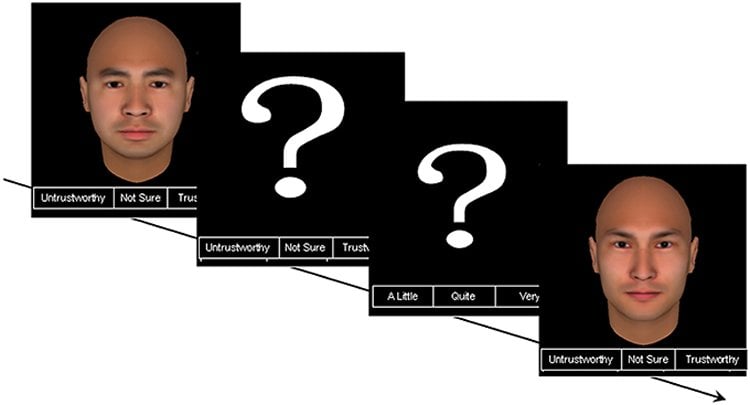Summary: According to researchers, children believe the less attractive you are, the less trustworthy you are.
Source: Frontiers.
A new study shows that children judge us on our looks – and beauty wins out on trustworthiness ratings.
Is beauty only skin deep? Children don’t seem to think so, like adults and babies, children think the uglier you are, the less trustworthy you are.
In a study recently published in Frontiers in Psychology, researchers have found that as children, how we perceive someone’s trustworthiness is linked to how attractive we find them. Our ability to make this trustworthiness judgement develops as we grow, becoming more consistent as we approach adulthood, and, girls are better at it than boys.
Many psychology studies have proven the existence of the so-called “beauty stereotype”. This describes the phenomenon whereby more attractive people are also considered to be smarter, more sociable and more successful. To be attractive is to be treated better by your peers, and preferred by new-born babies, than uglier people.
People use facial cues to make judgements on a person’s character – and this ability to infer social traits is a crucial part of social functioning and development. Although well researched in babies and adults, the development of this ability in children was not previously known.
Understanding this process paints a more complete picture of this development from birth through to adulthood. It also adds to a growing body of work showing that attractiveness is a universal language when it comes to that all-important first impression.
Dr Fengling Ma and Dr Fe Xu of Zhejiang Sci-Tech University, and Dr Xiaming Lu of Wenzhou Medical University, China, assessed 138 participants – groups of children aged eight, ten and 12 years old, and compared them to a group of adults.
They used a face generation program (FaceGen) to produce 200 images of male faces – all with a neutral expression and direct gaze. In the first of two sessions, each participant was shown each face, and asked to rate how trustworthy they thought that person was. A second session followed a month later where participants repeated the exercise, this time rating the attractiveness of the same faces.

The study analysed the responses of the children and adult control groups. The researchers looked firstly at the ratings of trustworthiness, and level of agreement of the ratings within and between the groups. Did the children within the same age groups agree on how trustworthy each of the faces was?
Did the responses of the different age groups agree with each other, and with the adult group? They found that the level of agreement within and between the age groups and the adult group increased with age. From this they were able to infer that the children’s ability to judge trustworthiness therefore also increased with age.
Next, the researchers looked at the ratings of trustworthiness and attractiveness given to each face. They found a strong, direct relationship between the two traits – the faces deemed more trustworthy were also considered to be more attractive. This relationship also strengthened with age, and reveals that, like adults, children also look to a person’s attractiveness as an indication of their character.
So, it appears that judging a book by its cover, however incorrectly, is something we are born to do.
Funding: This work was supported by the National Natural Science Foundation of China (grant number: 31170996; 31400892).
Source: Abigail Pattenden – Frontiers
Image Source: This NeuroscienceNews.com image is credited to Ma et al/Frontiers in Psychology.
Original Research: Abstract for “Children’s Facial Trustworthiness Judgments: Agreement and Relationship with Facial Attractiveness” by Fengling Ma, Fen Xu and Xianming Luo in Frontiers in Psychology. Published online April 12 2016 doi:10.3389/fpsyg.2016.00499
[cbtabs][cbtab title=”MLA”]Frontiers. “Ugly Truth: Children Less Likely to Trust Unattractive People.” NeuroscienceNews. NeuroscienceNews, 13 June 2016.
<https://neurosciencenews.com/trust-children-ugly-people-4452/>.[/cbtab][cbtab title=”APA”]Frontiers. (2016, June 13). Ugly Truth: Children Less Likely to Trust Unattractive People. NeuroscienceNews. Retrieved June 13, 2016 from https://neurosciencenews.com/trust-children-ugly-people-4452/[/cbtab][cbtab title=”Chicago”]Frontiers. “Ugly Truth: Children Less Likely to Trust Unattractive People.” https://neurosciencenews.com/trust-children-ugly-people-4452/ (accessed June 13, 2016).[/cbtab][/cbtabs]
Abstract
Children’s Facial Trustworthiness Judgments: Agreement and Relationship with Facial Attractiveness
This study examined developmental changes in children’s abilities to make trustworthiness judgments based on faces and the relationship between a child’s perception of trustworthiness and facial attractiveness. One hundred and one 8-, 10-, and 12-year-olds, along with 37 undergraduates, were asked to judge the trustworthiness of 200 faces. Next, they issued facial attractiveness judgments. The results indicated that children made consistent trustworthiness and attractiveness judgments based on facial appearance, but with-adult and within-age agreement levels of facial judgments increased with age. Additionally, the agreement levels of judgments made by girls were higher than those by boys. Furthermore, the relationship between trustworthiness and attractiveness judgments increased with age, and the relationship between two judgments made by girls was closer than those by boys. These findings suggest that face-based trait judgment ability develops throughout childhood and that, like adults, children may use facial attractiveness as a heuristic cue that signals a stranger’s trustworthiness.
“Children’s Facial Trustworthiness Judgments: Agreement and Relationship with Facial Attractiveness” by Fengling Ma, Fen Xu and Xianming Luo in Frontiers in Psychology. Published online April 12 2016 doi:10.3389/fpsyg.2016.00499






